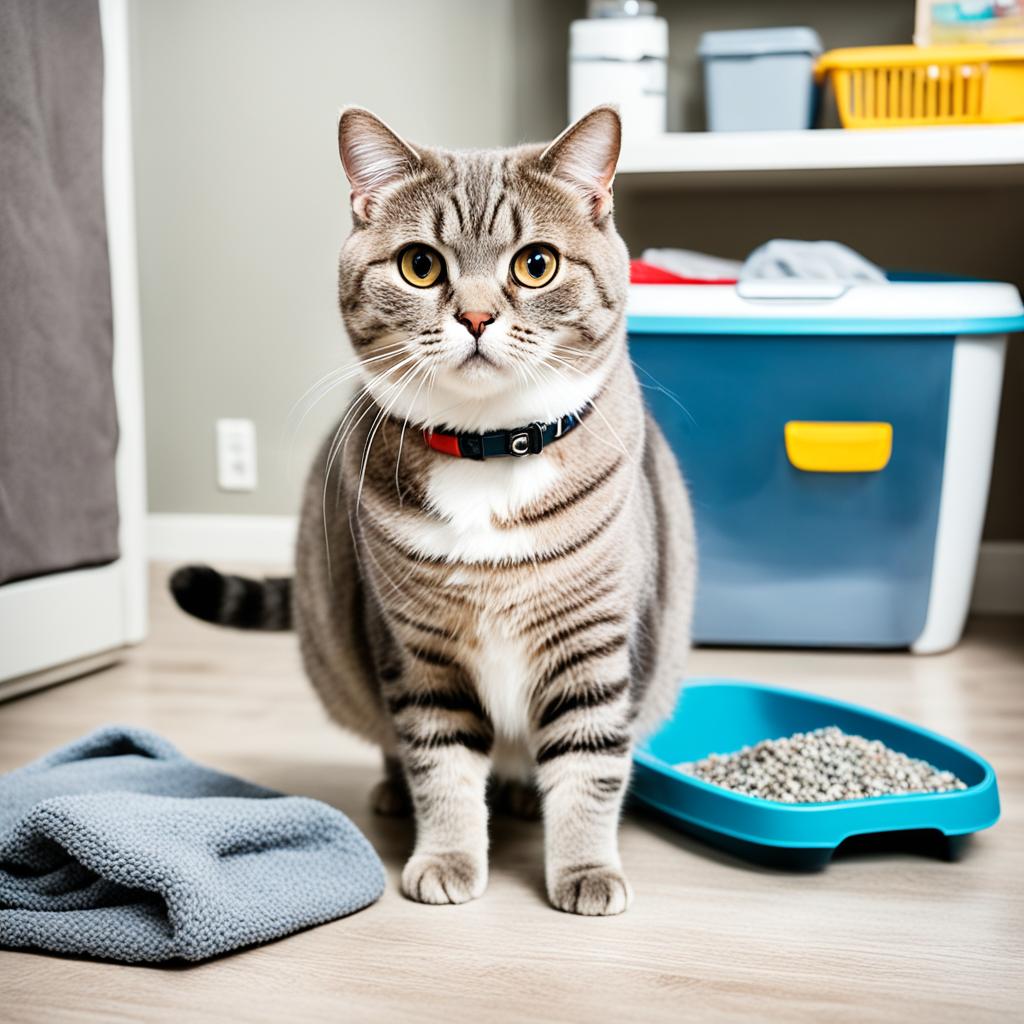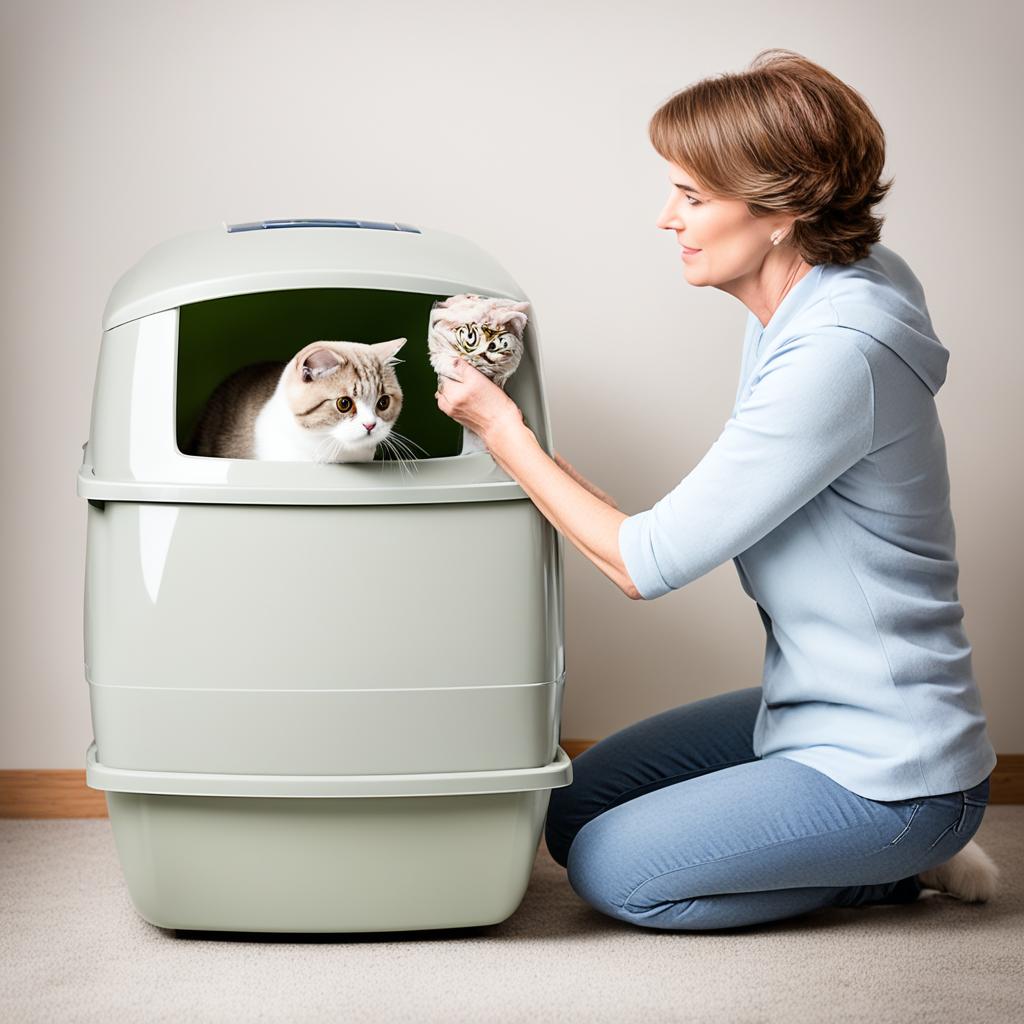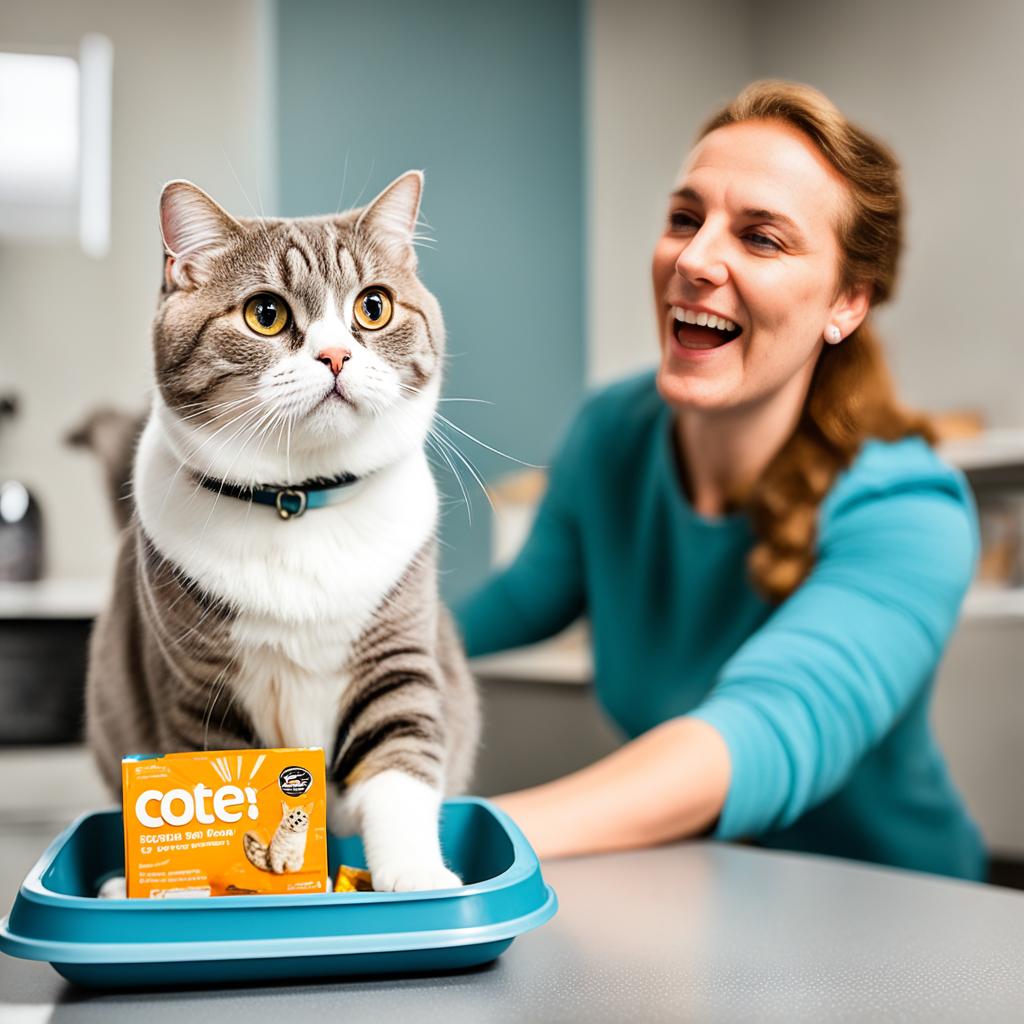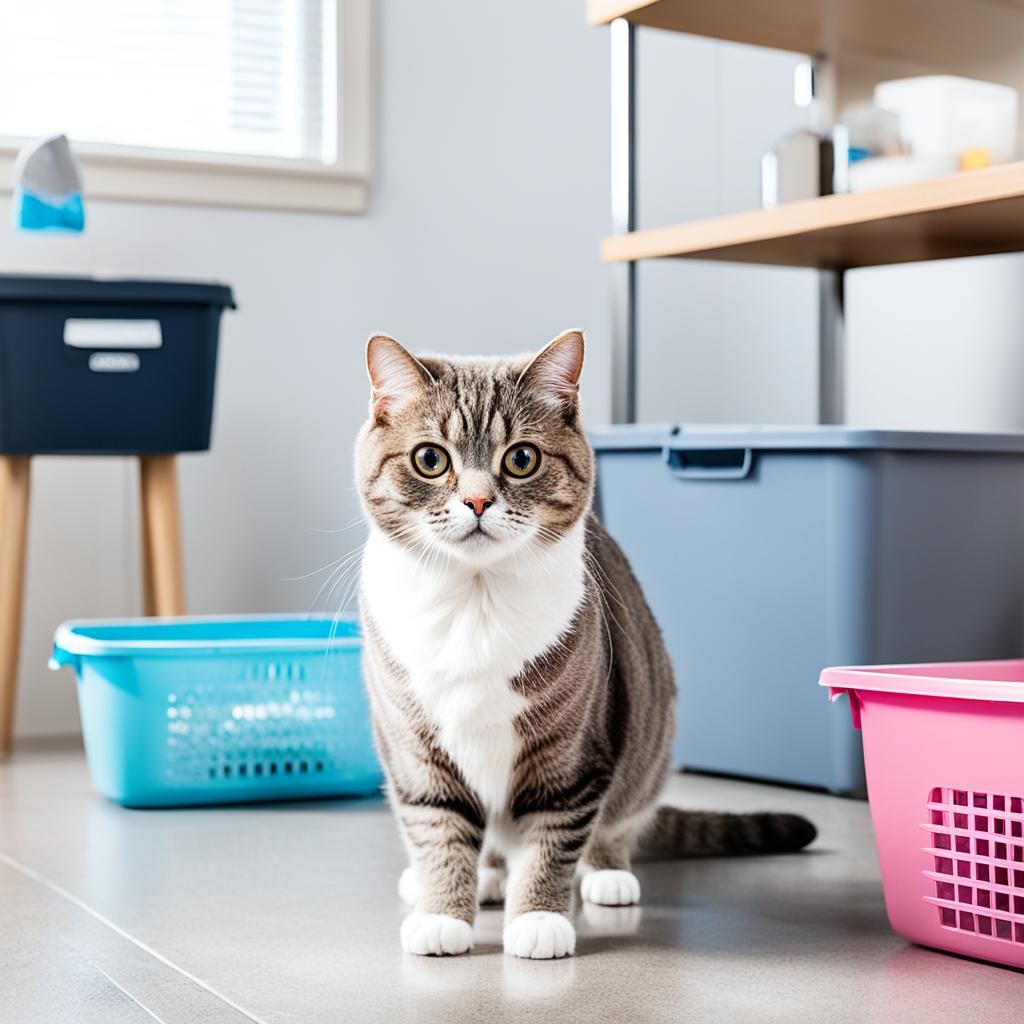Ever wondered why your Scottish Fold cat, with its unique folded ears and lovable personality, sometimes struggles with litter training? The journey to mastering litter box habits for your furry friend is both art and science.
Originating from a natural genetic mutation in Scotland, these affectionate, playful companions need special care. From selecting the perfect litter box to understanding their health needs, your Scottish Fold comes with its unique quirks. Regular vet check-ups and a balanced diet are essential, and with the right training tactics, you’ll bridge the gap between challenge and mastery, deepening your bond with your feline.
Key Takeaways
- Understand the unique origins and needs of your Scottish Fold cat
- Prepare by selecting the right litter box and knowing their preferences
- Regular veterinary care and proper diet help mitigate health risks
- Training with patience and a nurturing approach is key
- Consistent habits can establish a strong bond and smooth transition
Understanding the Natural Instincts of Scottish Folds

When embarking on the journey of litter training your Scottish Fold, it’s essential to understand their natural instincts. Much like their wild ancestors, Scottish Folds have ingrained behaviors that guide their actions. Knowing these instincts can help you choose the best methods for teaching a Scottish Fold Cat to use the litter box efficiently.
The Role of Ancestry in Litter Box Training
Believe it or not, your Scottish Fold shares over 95% of its DNA with tigers. This fascinating genetic connection plays a crucial role in their litter box training. Wild cats have a natural inclination to bury their waste to conceal their presence from predators and prey. This instinct makes methods for teaching a Scottish Fold Cat to use the litter box more intuitive. Leveraging these ancestral behaviors, such as their attraction to soft dirt-like litter, makes the training process smoother and more efficient.
How Natural Behaviors Influence Training
Scottish Folds display a variety of natural behaviors that can influence training outcomes. Their predilection for digging and covering their tracks is a behavior you can capitalize on during training. For successful behavioral training for Scottish Fold Cats, start by observing these behaviors and catering to their preferences. Choosing appropriate litter and maintaining a clean box can ensure a high training success rate. Aligning the training techniques with their instincts makes the process more natural and reduces the training time.
Preparing Your Home for Litter Training Success

The quest for a harmonious home starts with setting up the perfect environment for litter training your Scottish Fold. Understanding the nuances of how to train a Scottish Fold Cat to use a litter box can save you a ton of stress and those claws’ unfair vendetta against your sofa. Let’s break it down into manageable steps to help your furry friend feel right at home.
Selecting the Ideal Litter Box Location
Location, location, location! The mantra holds true, even when it comes to the litter box. You’ll want to place it in a quiet, private area that emulates the covert spots wild cats favor. Think of it as your cat’s own private sanctuary where it can “go” in peace. Ensure it’s away from the hustle and bustle of household activity, and definitely keep it far from the dining and hydration stations. Your cat’s sense of cleanliness rivals even Marie Kondo’s standards.
Essential Supplies You’ll Need
Equipping yourself with the right supplies is an integral part of Scottish Fold cat housebreaking techniques. Here’s what you’ll need:
- Clumping or Fine-Grain Litter: These types appeal to your cat’s instinctual love for soft, dirt-like textures.
- An Open Litter Box: Start with an open box for easy accessibility. You can upgrade to a closed one later if needed.
- Enzymatic Cleaners: Accidents happen, but enzymatic cleaners can erase any lingering scent markers that might tempt a repeat offense.
Multiple litter boxes are a must in a multi-feline household to prevent any territorial disputes. Follow these Scottish Fold cat housebreaking techniques, and your home will be a kitty paradise in no time.
Choosing the Right Litter and Box

When it comes to Training a Scottish Fold Kitten for the litter box, the choice of litter and the box itself can make all the difference. Your Scottish Fold has specific preferences rooted in their natural instincts, so finding the right fit ensures comfort and success.
Start with finely clumping clay litter that mimics the soft dirt they’re naturally drawn to. Avoid scented options as these might be off-putting to your kitten’s sensitive nose. Your Scottish Fold will feel more at ease with the familiar texture.
The size and design of the litter box also play a crucial role. For Scottish Fold Cat toilet training, choose a box that’s spacious enough for their medium build while providing some privacy. This privacy can help them feel secure and less exposed.
| Feature | Recommendation | Reason |
|---|---|---|
| Type of Litter | Finely Clumping Clay | Feels like natural dirt, preferred by cats |
| Scent | Unscented | Avoids overwhelming your kitten’s sensitive nose |
| Box Size | Medium to Large | Accommodates their build and provides comfort |
| Box Type | Low-Sided | Ease of access, especially for kittens or cats with joint issues |
For aging Scottish Folds or those with joint issues, consider a low-sided litter box. These are easier to access and prevent discomfort, encouraging consistent use and aiding in Scottish Fold Cat toilet training. With the right choices, you’ll pave the way to litter training success and a happy, healthy kitty!
How to Train a Scottish Fold Cat to Use a Litter Box?

Understanding how to train a Scottish Fold cat to use a litter box can be quite a rewarding journey. Leveraging their innate tendencies to dig and bury makes this process much smoother.
Step-by-Step Training Guide
When training a Scottish Fold kitten for the litter box, consistency is key. Start by placing your kitten in the litter box after meals, play sessions, and naps. These are the times they’re most likely to need to go. Reward them with positive reinforcement such as praise or a treat whenever they use the litter box correctly. Gradually, this will form a positive association with the litter box.
Recognizing Signs Your Cat Needs to Go
Observing your cat’s behavior is crucial in identifying when they need to go. Look for signs like scratching at the floor or circling. When you notice these behaviors, gently place your Scottish Fold in the litter box. Over time, this will help them associate these actions with using the litter box and enhance house-training efforts.
Overcoming Common Litter Training Challenges

Even seasoned cat owners might face a few challenges when it comes to Scottish Fold Cat housebreaking techniques. Fortunately, you can navigate these issues with some patience and innovative strategies. Let’s address some common hurdles and how to tackle them effectively.
Improper litter box usage is a frequent issue. Start by ensuring the box is clean and appealing. Cats, especially Scottish Folds, can be picky. If that doesn’t work, consider switching to an unscented litter or even relocating the box to a quieter spot. These simple changes can work wonders.
If you notice behavioral changes in your cat, it could signify an underlying health issue. The breed is prone to osteochondrodysplasia, a medical condition that might affect their litter box habits. Regular vet check-ups are crucial for diagnosing and managing such health concerns.
Address potential stressors—changes in the household, new family members, or even a switch in litter brands can send your cat into a tailspin. Maintaining a consistent environment can alleviate much of this stress.
“Stress relief and consistency are golden rules in behavioral training for Scottish Fold Cats” – anonymous pet enthusiast
If improper bathroom habits persist, consider deploying additional boxes. Some cats prefer different spots for different purposes. Also, multiple boxes prevent territory disputes in multi-cat households.
The bottom line is, by observing your cat’s behavior and responding accordingly, you can smoothly sail through these common litter training challenges. Scottish Fold Cat housebreaking techniques combined with patient observation and action will ensure success.
Behavioral Training Tips for Scottish Fold Cats

Managing your furry friend’s behavior may seem daunting at first, but with the right approach, it’s a breeze. Understanding behavioral training is crucial to grooming your Scottish Fold into a well-behaved companion.
Positive Reinforcement Techniques
The use of positive reinforcement techniques works wonders. Start by rewarding your Scottish Fold Cat for displaying desirable behaviors. Each time they use the litter box correctly or resist the urge to claw at furniture, a treat or soothing praise can motivate them to repeat these behaviors. The idea is simple—good behavior earns good things.
Dealing with Stubborn Behaviors
No need to pull your hair out over stubborn behaviors. Identifying the root cause—whether it’s stress, boredom, or an underlying health issue—can help in addressing them effectively. Engage your Scottish Fold in interactive play sessions, keeping their intelligent minds stimulated. Environmental enrichment, like scratching posts and puzzle feeders, keeps them entertained and reduces undesired behaviors. Consistency is your best friend here—stick to your training routine, and you’ll see progress.
Let’s also not forget the power of patience. Training a pet is a journey, not a sprint. With persistence, understanding, and the right positive reinforcement techniques, you’ll foster a harmonious living situation for both you and your Scottish Fold Cat. Remember, every bit of effort you put into Scottish Fold Cat training tips today is a step towards a happier, better-behaved kitty tomorrow.
| Training Tip | Description |
|---|---|
| Reward-Based Incentives | Give treats or praise for good behavior to encourage repetition. |
| Interactive Play | Engage your cat with toys and activities to keep their mind active. |
| Environmental Enrichment | Introduce scratching posts, puzzle feeders, and other stimulating items. |
| Consistency | Maintain a regular training routine to establish desired habits. |
Creating a Stress-Free Environment for Your Kitty

When it comes to creating a stress-free environment for Scottish Fold Cats, your efforts make all the difference in their overall well-being and successful litter training. Trust me, your furry friend will thank you!
First things first, let’s talk noise. You don’t want your Scottish Fold to feel like they are at a rock concert 24/7. Reduce loud noises around the house to help them stay calm. Invest in some soundproofing techniques if you live in a particularly bustling area.
Next, creating cozy hiding spots and elevated perches is a must. Your kitty will appreciate having a quiet corner to retreat to when they need some downtime. Think of it as their very own zen zone. It helps them feel secure and gives them a sense of control over their environment.
A stable daily routine can work wonders as well. Cats, much like humans, thrive on consistency. Feed them at the same times each day, and establish regular playtime sessions. This not only keeps their stress levels in check but also ensures they’re not waking you up at ungodly hours demanding breakfast.
When it comes to enrichment, don’t skimp on the toys and interactive activities. Keeping your Scottish Fold entertained can alleviate boredom and prevent stress-related behavior issues. Rotate their toys regularly to keep things fresh and exciting.
In summary, creating a stress-free environment for Scottish Fold Cats involves a mix of minimizing chaos, providing comfortable retreats, sticking to a routine, and ensuring plenty of stimulation. You’ll create a haven where your kitty feels safe, comfortable, and ready to conquer the litter box like a pro.
The Importance of Hygiene and Litter Box Maintenance

Maintaining a clean litter box is not just about aesthetics; it’s pivotal for your Scottish Fold Cat’s overall health and well-being. Effective hygiene practices can significantly improve your cat’s comfort and reinforce positive toilet training habits.
Daily and Weekly Cleaning Routines
Consistency is key in keeping your cat’s litter box inviting. Here’s a breakdown:
- Daily tasks: Remove waste every day. This simple step helps keep the box hygienic and pleasant for your Scottish Fold.
- Weekly tasks: Take a deeper dive into cleanliness by completely emptying and washing the box. Use enzymatic cleaners to eliminate any lingering odors and bacteria.
By adhering to these routines, you not only maintain hygiene but also promote successful Scottish Fold Cat toilet training.
Preventing Odors and Unwanted Behaviors
The importance of hygiene and litter box maintenance extends to preventing unwanted behaviors. A foul-smelling or dirty litter box can lead to house soiling. Implement these strategies to keep both odor and bad habits at bay:
- Odor elimination: Utilize odor-neutralizing products and proper ventilation. Enzymatic cleaners are your best friend here.
- Behavior management: Keep the litter box in a location where your cat feels safe and secure. If re-soiling occurs, check for cleanliness and experiment with box relocations.
Regular maintenance and attention to your cat’s needs ensure healthy habits and a stress-free environment.
| Task | Frequency | Tools Needed |
|---|---|---|
| Waste Removal | Daily | Scoop, Disposal Bags |
| Box Cleaning | Weekly | Enzymatic Cleaner, Water, Soap |
| Odor Management | As Needed | Odor Neutralizer, Ventilation |
Commit to these practices to ensure your Scottish Fold Cat’s toilet training success and uphold the importance of hygiene and litter box maintenance.
Monitoring Your Cat’s Health During Litter Training

Ensuring the health of your Scottish Fold is essential during litter training. Due to their genetic makeup, they are prone to specific health issues which can influence litter habits. Keeping a vigilant eye on changes in elimination behaviors can provide early warning signs of potential problems.
Incorporate regular veterinary check-ups to catch any issues early. Conditions like osteochondrodysplasia can affect your cat’s ability to use the litter box comfortably, so it’s imperative to be proactive. A balanced diet and regular exercise also contribute significantly to overall health, making Scottish Fold Cat toilet training more manageable.
Watching for unusual litter habits is crucial. These may hint at discomfort or health concerns. Early intervention helps prevent these issues from escalating. Monitoring Scottish Fold Cats’ health ensures not only a smooth training process but also contributes to a happy and healthy life for your furry friend.
Conclusion
Successfully litter training your Scottish Fold cat involves a mindful blend of understanding their natural instincts and creating a supportive environment. Start by recognizing their inherent behaviors that trace back to their wild ancestry. Provide a quiet, accessible, and private litter box space that speaks to their desire for discretion.
Choosing the right litter and box goes a long way. Opt for finely clumping clay litter to mirror the soft dirt they naturally prefer. Complement this with a box that is both appropriately sized and offers easy access, particularly for kittens or older cats sensitive to joint pain.
Harness effective Scottish Fold cat training tips, incorporating consistent positive reinforcement to foster desired behaviors. Keeping the litter box clean and ensuring overall household hygiene will prevent odors and discourage unwanted habits.
Always monitor your cat’s health and adapt to any behavioral cues that suggest discomfort. By implementing these strategies, you’ll not only master litter training but also strengthen the bond with your affectionate and intelligent Scottish Fold, ensuring a harmonious coexistence.




